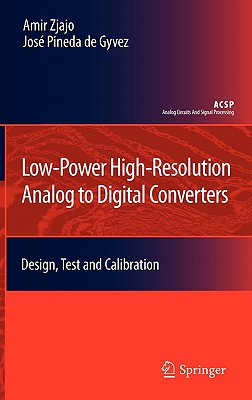Circuit Techniques for Low-Voltage and High-Speed A/d Converters (Hardcover)
暫譯: 低電壓與高速A/D轉換器的電路技術 (精裝版)
Mikko E. Waltari, Kari A.I. Halonen
- 出版商: Kluwer Academic Publ
- 出版日期: 2002-10-31
- 售價: $830
- 貴賓價: 9.8 折 $813
- 語言: 英文
- 頁數: 254
- 裝訂: Hardcover
- ISBN: 1402072449
- ISBN-13: 9781402072444
-
相關分類:
電路學 Electric-circuits
下單後立即進貨 (約5~7天)
買這商品的人也買了...
-
 Visual C++ 6 教學手冊 (Beginning Visual C++ 6)
Visual C++ 6 教學手冊 (Beginning Visual C++ 6)$580$458 -
 計算機組織與設計--軟硬體界面第二版 (Computer Organization & Design, 2/e)
計算機組織與設計--軟硬體界面第二版 (Computer Organization & Design, 2/e)$680$537 -
 Data Mining: Concepts and Techniques
Data Mining: Concepts and Techniques$2,470$2,347 -
 Pattern-Oriented Software Architecture Volume 2: Patterns for Concurrent and Networked Objects (Hardcover)
Pattern-Oriented Software Architecture Volume 2: Patterns for Concurrent and Networked Objects (Hardcover)$3,130$2,974 -
 SQL Server 2000 設計實務
SQL Server 2000 設計實務$650$553 -
 C++ Primer, 3/e 中文版
C++ Primer, 3/e 中文版$980$774 -
 LPI Linux 資格檢定 (LPI Linux Certification in a Nutshell)
LPI Linux 資格檢定 (LPI Linux Certification in a Nutshell)$880$695 -
 Design of Multi-Bit Delta-Sigma A/D Converters (Hardcover)
Design of Multi-Bit Delta-Sigma A/D Converters (Hardcover)$960$941 -
 Visual C#.NET 程式設計經典
Visual C#.NET 程式設計經典$650$514 -
 JavaScript 範例活用辭典
JavaScript 範例活用辭典$450$351 -
 PHP & MySQL 完全架站攻略第二版
PHP & MySQL 完全架站攻略第二版$620$527 -
 802.11 無線網路技術通論 (802.11 Wireless Networks: The Definitive Guide)
802.11 無線網路技術通論 (802.11 Wireless Networks: The Definitive Guide)$760$600 -
 ASP.NET 程式設計徹底研究
ASP.NET 程式設計徹底研究$590$466 -
 Embedded Linux 嵌入式系統原理與實務
Embedded Linux 嵌入式系統原理與實務$860$731 -
 Windows Server 2003 網路與 IIS 架站指南
Windows Server 2003 網路與 IIS 架站指南$680$537 -
 STRUTS 實作手冊(Struts in Action: Building Web Applications with the Leading Java Framework)
STRUTS 實作手冊(Struts in Action: Building Web Applications with the Leading Java Framework)$690$538 -
 LDAP 系統管理 (LDAP System Administration)
LDAP 系統管理 (LDAP System Administration)$620$490 -
 鳥哥的 Linux 私房菜-伺服器架設篇
鳥哥的 Linux 私房菜-伺服器架設篇$750$638 -
 鳥哥的 Linux 私房菜─基礎學習篇增訂版
鳥哥的 Linux 私房菜─基礎學習篇增訂版$560$476 -
 Outlook 2003 私房書
Outlook 2003 私房書$299$254 -
 人月神話:軟體專案管理之道 (20 週年紀念版)(The Mythical Man-Month: Essays on Software Engineering, Anniversary Edition, 2/e)
人月神話:軟體專案管理之道 (20 週年紀念版)(The Mythical Man-Month: Essays on Software Engineering, Anniversary Edition, 2/e)$480$379 -
 JSP 2.0 技術手冊
JSP 2.0 技術手冊$750$593 -
 Windows XP 威力大補完
Windows XP 威力大補完$199$157 -
 TQC 2003 企業用才電腦實力評核─辦公軟體應用篇
TQC 2003 企業用才電腦實力評核─辦公軟體應用篇$400$316 -
 ASP.NET 2.0 深度剖析範例集
ASP.NET 2.0 深度剖析範例集$650$507
相關主題
商品描述
商品描述(中文翻譯)
隨著電子應用領域的數位化日益增加,從電信系統到消費電子產品,對於模擬轉數位轉換器(ADC)的需求也隨之提升,要求其具備更高的取樣率、更高的解析度以及更低的功耗。集成電路技術的演進在某種程度上有助於滿足這些需求,透過提供更快的設備並實現更複雜的功能於特定的矽區域,但同時也帶來了新的挑戰,其中最重要的是供應電壓的降低。基於開關電容(SC)技術,管線架構最成功地利用了CMOS技術的特性來實現高速高解析度的ADC。對供應電壓和技術縮放對SC電路影響的分析顯示,至少在接下來的幾個技術世代中,可以期待其帶來的好處。運算放大器是SC電路中的核心構建塊,因此對不同拓撲及其低電壓能力進行了比較。眾所周知,標準形式的SC技術不適用於非常低的供應電壓,主要是因為開關控制電壓不足。研究了兩種低電壓的修改方案:開關引導(switch bootstrapping)和開關運算放大器(SO)技術。為這兩種方案提出了改進的電路結構。展示了兩個使用SO技術的ADC原型,同時在另外三個原型中使用了引導開關。ADC的一個重要組成部分是前端取樣保持(S/H)電路。在高信號頻率下,其線性度主要由所使用的開關決定。對S/H架構進行了回顧,並研究了通過引導技術進行開關線性化的應用,並將其應用於兩個原型中。另一個重要參數是取樣時鐘抖動,對其進行了分析,並通過精心設計的時鐘生成和緩衝來最小化。通過使用並行性,可以提高ADC的吞吐量。這在電路層面上通過雙重取樣技術得以展示,該技術應用於S/H電路和管線ADC。對雙重取樣中的非理想性進行了分析。在系統層面上,並行性被應用於時間交錯ADC。並行信號路徑的失配會產生錯誤,為消除這些錯誤,開發了一種對時間偏移不敏感的取樣電路和數位偏移校準。低電壓和高速A/D轉換器的電路技術展示了總共七個原型:兩個雙重取樣的S/H電路、一個時間交錯ADC、一個IF取樣自校準的管線ADC、一個帶去毛刺器的電流引導DAC,以及兩個採用SO技術的管線ADC。這本專著將成為活躍於模擬電路設計和通訊領域的學術界和專業人士的有用參考資料。















